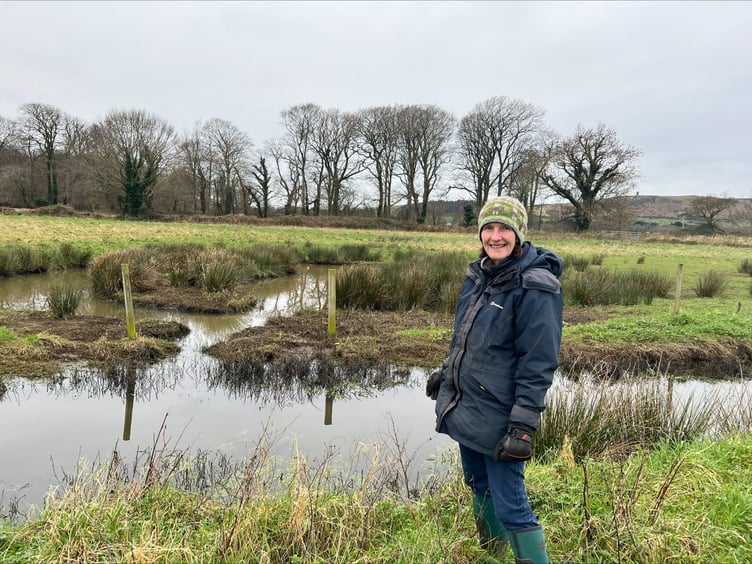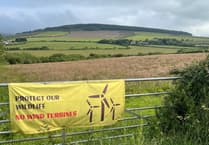Jenny Shepherd is proving that farmers can work with wildlife.
With partner Rawdon Hayne, she farms at Ballacosnahan in Patrick.
They have about 500 loaghtan sheep and are undertaking various projects to encourage wildlife to the area.
Jenny, a former hospital dermatologist, grew up on the farm and knows it well.
She took over, at first part-time, in 2014 after the tenant farmer moved out. The farm has always been owned by her family.
Since then she has set about ensuring that the farm is as wildlife-friendly as possible. It will take time but it is getting there.
The first step was to farm loaghtans, the four-horned native Manx breed of sheep.
‘I’ve always been involved with loaghtans,’ Jenny, who has lectured all over the world about the breed, said. ‘I knew all about them and I loved them.
‘So when I took over the farm, the only sheep I wanted were loaghtans.
‘These sheep are very endangered – far more endangered than most people realise.
‘What I wanted to do was show they could be commercially viable in the hope more people would keep them.
‘People are realising there is value in the meat.’
The farm shop sells not only the meat but fleeces and wool.
Farming loaghtans is one of many steps she has taken.
‘I knew this farm like the back of my hand from childhood,’ Jenny said. ‘I remember the curlews nesting, all the mountain hares and many of them have disappeared.
‘It’s seven years since I heard a curlew. So it mattered to me to try to farm but encourage nature to come back.
‘From 2016 we took the policy that we’d use no fertiliser, no pesticides, no weedkiller and farm with what we’ve got.
‘Loughtans let you do that. They don’t like pristeen grass. They like mixed herbage, more moorland-type terrain. That’s why they’re used as conservation grazers by the RSPB and the National Trust. A lot of people across use them for conservation grazing and they’re brilliant at that.’
She said the sheep were helping her to redress some of the losses in nature.
‘We took a hit. The old agricultural subsidies certainly didn’t reward you for having forests or trees. But I was happy to take a small hit on that.
‘Then we got the government’s Agri-Environment Scheme. It could have been written for us.’
The Manx Wildlife Trust has a role in the Agri-Environment Scheme and Jenny is now working with David Bellamy, the trust’s head of conservation.
Various parts of the farm are being used for different things.
‘At the top of the farm we’re trying to attract curlews back so we have no livestock on it from Christmas through to August because I don’t want the curlews to be disturbed,’ Jenny said.
Unfortunately, hooded crows and ravens remain a threat to the curlews.
The fields were used for hay until Jenny made the changes.
‘It’s managed moorland. It’s a beautiful area. The plant survey last year showed a massive increase in orchids and wild flowers.
‘So the meadows up there now I don’t use for hay. I’m deliberately trying to encourage more wild flowers.
‘I don’t want to plant non-native species. I want it to happen naturally.
‘It’s a slow process but it’s happening.’
She said that to help that along, one should encourage yellow rattle, a weed that suppresses the grass, which allows wild flowers to grow.
‘Gradually we’re getting more and more wild flowers. To be honest, we’re probably looking at 10 years before we see a picturebook meadow but it is beginning to happen.
‘We have seen a big increase in mountain hares over the last few years.’
The changes to the subsidy system means that Jenny is now being rewarded for leaving those fields to grow wild flowers.
Jenny has also built two big ponds at the top of the farm, one with an island.
‘It’s great in the summer,’ she said. ‘We’re beginning to see loads of dragonflies. I have noticed the increase in insects.
‘In the winter, every time I walk up there I disturb two or three mallard who have taken up residence there.’
‘We’ve always had swallows here. We do everything we can. We’ve made sure there’s no way they could ever be shut in an outbuilding.
‘Any that do shut now have a chunk cut out of the corner so they don’t get trapped.’
Manx Wildlife Trust ringed some last year to see if they’re coming back.
‘The swallows all use the ponds for drinking in summer. You can sit there for hours and watch. It’s beautiful to watch them swoop down to drink so skilfully.’
They have also put up birdboxes to encourage more to nest, which is something that is also subsidised.
Among the other birds Jenny has noted have been harriers and buzzards.
The water and the wildflowers give habitats and food for insects. The more insects, the better the food chain and the easier it is for birds find food.
Fields cut for hay have a verge of 12 to 16 feet uncut at the edges to encourage wildlife.
Jenny is also working with the MWT on wetlands in the bottom 28 acres of the farm.
‘That’s in the flood plain of the River Neb. It hardly ever flooded years ago but now it is quite a regular occurrence.
‘When the River Neb bursts its banks into our field, I cannot tell you how fast it moves. We had sheep down there in the early days and we twice lost sheep into Peel harbour and they were washed out to sea.
‘In the winter we had to stop using that area for grazing.’
Climate change has played a part in the increased flooding, but also Jenny suspects that manmade changes to the river downstream have had a role too.
‘I got together with David Bellamy to turn it into a wetlands. We started just over a year ago.
‘We stopped ditching. We have dug a few scrapes and a couple of ponds so we have water for livestock. In the summer it is grazed and it’s also the area from which we get most of our hay.
‘It is still used for farming but I feel that to make it a wetlands in winter is just such a perfect way of using it. I’m actually encouraging it to flood now.
‘The first bird survey we did last February absolutely blew me away. We found woodcock, snipe, jack snipe – so already it’s beginning to draw in more birds.
‘It’s a 10-year project but I’m hoping that as it becomes more established it will attract more.’
The grass too dominant the moment. Jenny said she’d like to borrow hardly native cattle to eat down a lot of rough grass.
The area near the Neb has a history as a wetland.
‘It was called curraghs [a Manx word for wetlands, most famously still used for the Ballaugh Curraghs] on a 1904 map. So we now call it the Ballacosnahan Curraghs.
‘We used to play down there as kids. The river was a magnet. The rule was you can go and play there but not on your own, there had to be quite a lot of you. So we were given a lot of freedom as kids.
‘I remember as a child certainly hearing water rails down there and I have a feeling there were corncrakes. Certainly there were kingfishers – not very common but we did see them. I would love to get them back.’
In the summer they saw a moorhen nesting in the reeds. A partridge nested in the longer grass.
‘The eventual hope is that we can make money from agri-tourism or eco-tourism by putting some hides down there and proper walkways.
‘I don’t want visitors tramping over everything so if we confine people to designated paths with hides and people pay to use them for the day or visit, what a great way for the farm to make money and actually increase wildlife.
‘The bird places in the UK in wetlands are full of hides which are used the whole time. That would be my dream – that the birds were earning us money down there. I think it’s an exciting project because we’re turning to back to what it was over 100 years ago.’



.png?width=209&height=140&crop=209:145,smart&quality=75)
-(1).jpeg?width=209&height=140&crop=209:145,smart&quality=75)